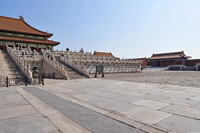| dc.coverage.spatial | Site: Forbidden City (Beijing, Beijing Shi (municipality), China) | en_US |
| dc.coverage.temporal | 1420 (creation); 1695 (alteration) | en_US |
| dc.creator | unknown (Chinese) | en_US |
| dc.date | 1420 | en_US |
| dc.date.accessioned | 2013-08-07T18:20:06Z | |
| dc.date.available | 2013-08-07T18:20:06Z | |
| dc.date.issued | 1420 | en_US |
| dc.identifier | 229442 | en_US |
| dc.identifier.other | archrefid: 2516 | en_US |
| dc.identifier.uri | http://hdl.handle.net/1721.3/137226 | |
| dc.description | South flank looking northeast; In the first hall, the Hall of Supreme Harmony (Taihe dian), the most important state ceremonies took place: enthronements, New Year celebrations, the emperor’s birthday etc. The hall, first built under the Ming dynasty in 1420 and called the Hall of Offering to Heaven (Fengtian dian), was renovated and renamed under the Kangxi emperor in 1695. Standing 28 m above the Dragon Pavement terrace, and with an area of 2377 sq. m, the eleven-by-five bay building is the largest in the Forbidden City. Two narrow side corridors are the only division of the interior space. Inside the hall, on a wooden podium (h. 2 m), stands the gold-lacquered throne. Source: Grove Art Online; http://www.oxfordartonline.com/ (accessed 5/19/2011) | en_US |
| dc.format.medium | wood; stone | en_US |
| dc.rights | © Scott Gilchrist, Archivision, Inc. | en_US |
| dc.subject | architecture | en_US |
| dc.subject | decorative arts | en_US |
| dc.subject | historical | en_US |
| dc.subject | rulers and leaders | en_US |
| dc.subject | audience hall | en_US |
| dc.subject | Chinese | en_US |
| dc.subject | Ming | en_US |
| dc.subject | Qing | en_US |
| dc.title | Forbidden City: Hall of Supreme Harmony (Taihe Dian) | en_US |
| dc.title.alternative | Hall of Supreme Harmony (Taihedian) | en_US |
| dc.title.alternative | 太和殿 | en_US |
| dc.type | image | en_US |
| dc.rights.access | Licensed for educational and research use by the MIT community only | en_US |
| dc.identifier.vendorcode | 1A2-CH-B-FC-HSH-A3 | en_US |
| vra.culturalContext | Chinese | en_US |
| vra.technique | construction (assembling), carving (processes), painting and painting techniques | en_US |
| vra.worktype | throne room | en_US |
| vra.worktype | reception room | en_US |
| dc.contributor.display | unknown (Chinese) | en_US |


